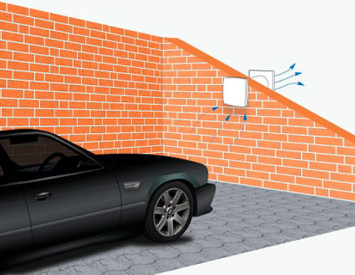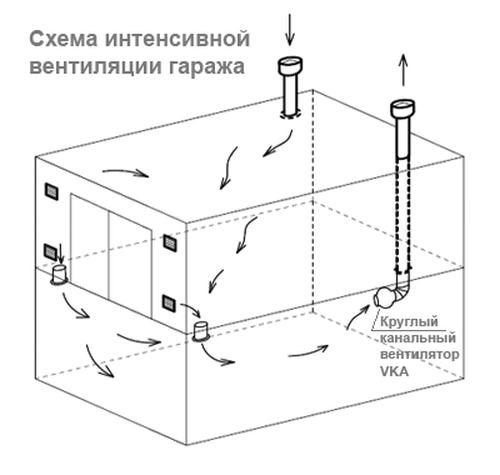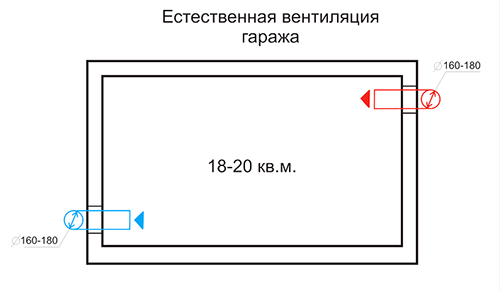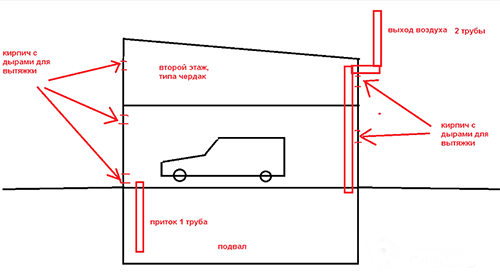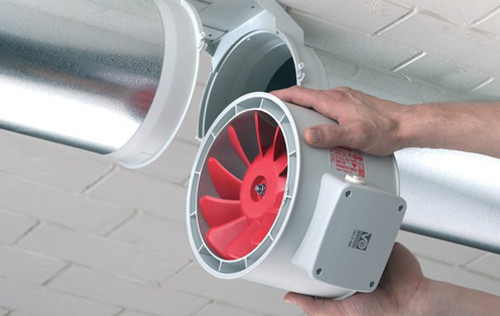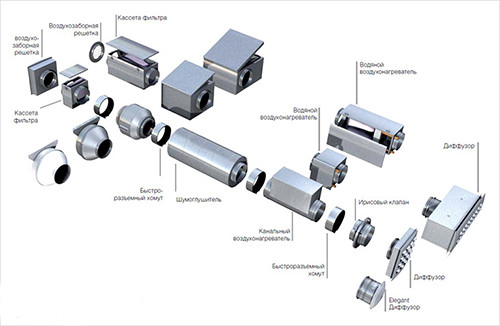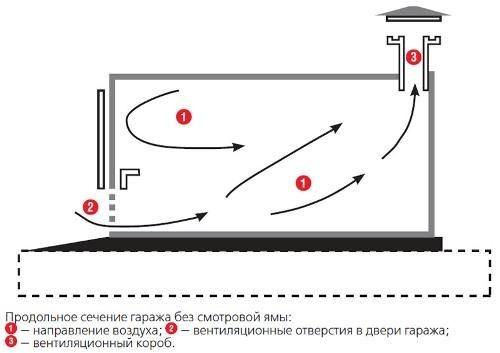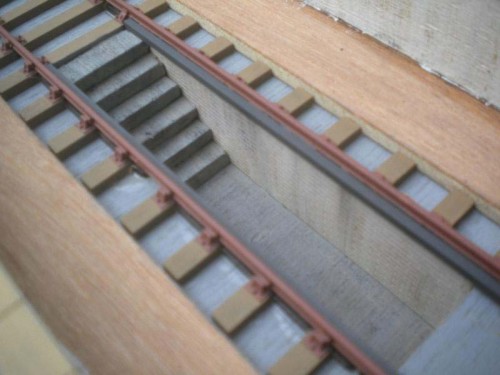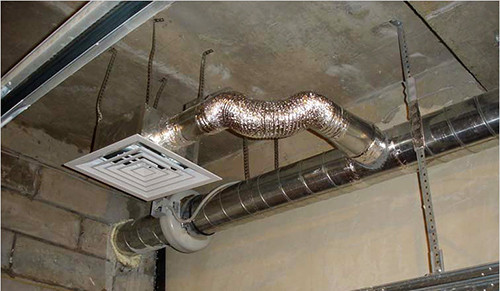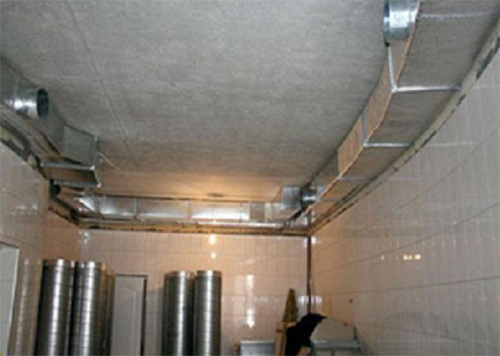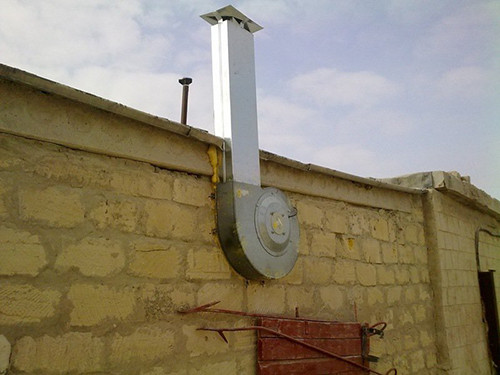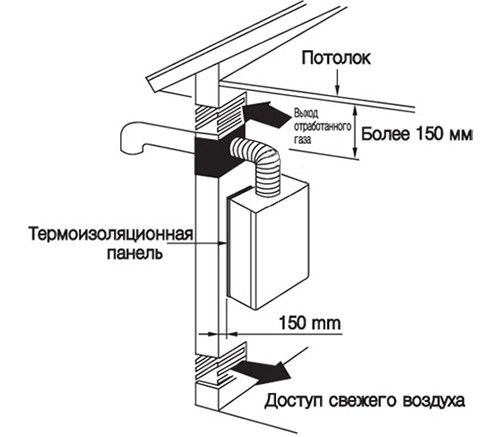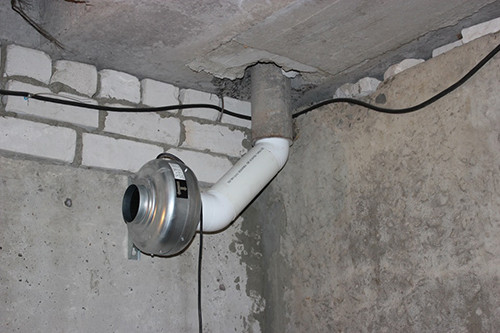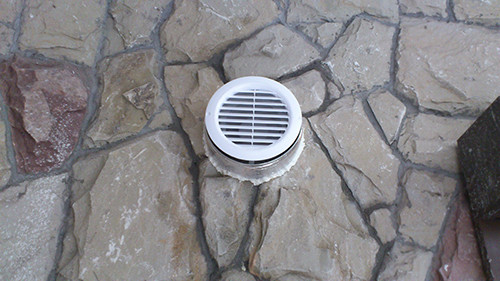Each owner of the car wants his car to serve as long as possible and at the same time does not lose an attractive appearance. To do this, it is necessary to regularly make inspection, take care of the car, but the main thing is to ensure the proper conditions of “storage”. If the car is idle on the street in the open, then it will quickly begin to rust, the paint will fade, scratches and chips will appear on the body. If you close it behind the seven locks in the airtight room, this will also be not enough for this - it is impossible to be in the stuffy space for a long time and maintain the maintenance of equipment. To avoid such troubles, it is necessary to install a ventilation system. We will talk about how to do ventilation in the garage in the garage in today's article.
Content
The device of ventilation systems
The primary task of any garage is to protect the car from encroachments of attackers and atmospheric influences. However, it is not enough to simply build a “box” and put a machine in it, it is necessary to create comfortable conditions inside: humidity, temperature, etc. If there is no ventilation system in the garage, stray air and high humidity will always reign there. This will lead to the active development of corrosion in the vulnerable places of the building and will significantly reduce the life of the machine.
What functions does ventilation in the garage:
- It takes or evaporates water vapors, inevitably formed as a result of penetration inside the snow, dirt or rain drops when the car is driving from the street.
- Derises evaporation and gases harmful to human health.
- Draises the body of the car after traveling in bad weather.
- The condensate that appears on the internal surfaces of the garage, thereby extending the duration of its operation, is timely.
- Draises the observation pit and the basement in the garage, if any.
To do all this possible, it is necessary to choose the right and install one of the types of ventilation systems: natural, forced or mixed. Consider the advantages and disadvantages of each of them.
Natural ventilation
Natural ventilation is the smallest and cheapest way to ensure ventilation of the garage. This explains its popularity. The air enters through the supply holes placed in the lower part of the gate. Fresh air flows penetrate them, pass through the floor at the bottom of the car, gradually heat up and rise up, taking condensate, toxic gases and evaporation with them. At the ceiling of the garage there are other holes - exhaust. Through them, the designed air comes out.
In order for the system to work uninterruptedly and efficiently, it is necessary to correctly choose the cross -section of the supply and exhaust ducts. The exhaust pipe should be made of asbestos or tin and rise above the roof level by at least 50 cm to create a traction of the required power. If there is no traction, the exhausted air will not come out from the inside or it will go very slowly. It is also recommended to organize a thermal insulation casing around the exhaust pipe so that in the cold season the condensate does not freeze and does not clog it.
Why does the air begin to move and flow in the right direction? Circulation is carried out due to different density of waste and fresh air, as well as due to the emerging thrust in the pipes. But if the volumes of the exhaust air are too large, and the natural system cannot cope, it is necessary to install a combined type system.
Mixed ventilation
A similar ventilation system in the garage combines the principle of natural and forced. The air flows through the supply pipe, and is excreted by means of a fan operating from the network and installed in the exhaust opening under the ceiling. The fan sucks the spent air masses and removes them from the room faster.
To make such a system as effective as possible, you need to choose the right power of the exhaust fan. For the garage, it is desirable that it is at least 100 watts. The quality of the product also matters - it should be reliable and durable, provided that it is continuous.
The main drawback of the combined ventilation system is the hypothermia of the garage in winter. Cold air quickly penetrates inside and just as quickly goes outside. The absence of a filter in the supply hole can also cause inconvenience.
Forced ventilation
Forced or fully mechanized ventilation in the garage is perhaps the best solution. In this case, the flow of air and its excretion is carried out by autonomous subsystems, which completely eliminates the disadvantages of the above methods.
The supply ventilation in the garage consists of an air duct with a filter, fan and caloriece. When the fan sucks the air from the street, it is immediately cleaned, passing through the filter and heats up in a high -calorifier. Thus, in the garage it will be warm even by the most frosty winter. The exhaust garage ventilation subsystem is an axial fan, which can be supplemented with a channel fan.
When arranging a forced system, modular structures or monoblocks are used. The former involve the installation of autonomous blocks for the influx and removal of air, combined into a single system by means of sensors. Monoblock is a single box (block), in which both the influx and the hood occur. Monoblocks with lamellar recuperators are considered the most effective, which heat the incoming clean air, thereby reducing heating costs.
You should choose a garage ventilation scheme during design, but even if the garage is already used, you can enter the system into a general layout. Of course, this will take more effort, time and money, but you already know what can happen in the garage without ventilation. If there is heating in the room, it is most reasonable to use a forced system with a recuperator, and a conventional natural scheme is suitable for an unheated.
Useful advice: on all ventilation holes, regardless of the type of system, install protective nets or grilles so that insects do not penetrate the garage, rodents, the duct does not clog with garbage.
Features of installation
Each of the ventilation systems has its own installation technology, requires certain skills, differs in the cost and nature of service. In this chapter, we will consider in detail the features of the ventilation device in the garage with our own hands.
Natural ventilation
It is easiest to make natural ventilation, but before going to the store for pipes and bars, it is necessary to calculate to find out the cross -section of these pipes. It depends on how quickly it can pass fresh air and remove the worked out on the section of the duct. And this, in turn, determines the quadrature of the garage and the speed of its pollution. There are some requirements of the organization of natural ventilation, which say that for each m² there should be 1.5 cm of the duct. That is, if you own a garage with an area of \u200b\u200b18 m², it means that for ventilation it needs an duct with a diameter of 18*1.5 \u003d 270 mm. But if you want to install two exhaust pipes in different corners of the garage, then this value should be divided into two and buy 135 mm air ducts in diameter.
How to make ventilation in the garage:
- Make a hole for the supply pipe as low as possible. Ideally, it should be located only 30-50 cm from the floor.
- Keep in mind that the total diameter of the supply ducts should exceed the diameter of the exhaust ducts by 2 times.
- It is better to make the supply holes from the north side of the garage so that the wind in them blow out as much as possible.
- To make a good extract of the exhaust air, place the duct's hole at the highest garage point, that is, either on the roof or under the ceiling.
- The higher the exhaust pipe, the better. From it to the supply opening should be at least 3 m. If the garage with a gable roof, then the extract of the hood can be drawn through the attic to the ridge.
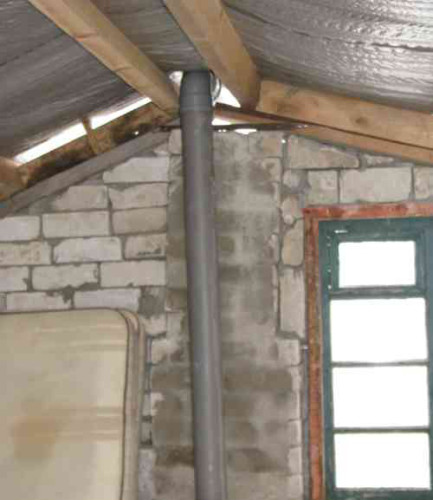
- The output of the exhaust pipe must be closed with a canopy or visor so that precipitation, garbage or insects do not penetrate there.
- Make the hood so that the direction of the duct coincides with the direction of the wind (the wind should not blow into it so as not to break the thrust). To do this, you need to find out which direction of the wind prevails in your region.
- An empty space will remain between the duct and the wall - fill it with mounting foam and sealant.
As you can see, the natural ventilation of the garage with your own hands is very simple in the arrangement, so even newcomers should not have difficulties in this matter. The cost of the work is minimal, especially if you take into account that the air ducts can be glued from galvanizing or sheet steel.
But before deciding to make such ventilation in your garage, you should take into account its main drawback - the air will circulate only at temperatures on the street up to +12C. In the summer, air exchange will be quite weak, so you may need to install additional fans, but more on that below.
Combined ventilation
The principle of arranging a combined ventilation system is almost the same as described above, with the only exception that a fan is installed in the exhaust hole that sucks out the exhaust air and pushes it out through the duct. Another nuance - the supply and exhaust holes can be located at any point of the garage, but not on the contrary, otherwise there will be no air circulation.
For ducts, you can use plastic or metal pipes, the diameter of which you already know how to calculate. The combined system provides effective garage ventilation all year round, regardless of temperature on the street. The fans themselves do not consume so much energy, so you will not feel a significant difference in payment of accounts. The only thing to consider is the active penetration of cold air in winter, since the supply hole is not equipped with any heating devices. Well, if you equip it with such, and even put a filter, then it will already be a fully mechanized ventilation system. Of course, it is much better than natural and combined, but it costs an order of magnitude more expensive.
How to make a simple and effective combined ventilation in the garage watch in the video below:
Pit and basement ventilation
It is easy to guess that if the air enters the garage through the hole is low from the floor, and go out-somewhere under the ceiling, then the observation pit and the cellar will be left without attention. It is very uncomfortable to work in a stuffy pit under the machine, and if you do not provide air circulation in the basement, mushroom plantation will grow very quickly there.
To equip the ventilation of the observation pit, on the sides located closest to the supply hole, open it 10-15 cm so as not to get injured, accidentally stepping there. If the tributaries are on both sides of the pit, make cracks on both sides. Between the plate of the hole of the pit in a place located directly opposite the exhaust hole, make slots with a width of 5-10 cm.
If the supply opening is 2 times wider than the exhaust, natural traction will occur in the pit, and the air masses will be independently replaced. At the same time, try to install the car so that it does not overlap the exhaust gap of the pit. There is a plot of the most aggressive environment, and if the exhaust air from the pit will blow into the car body, it is in this place that it will begin to rust and rot first of all.
How to make ventilation in a garage with a basement? In this case, you will have to equip a separate ventilation system in the cellar with your supply and exhaust duct. The basement itself is always very raw, and there is a fairly powerful air circulation.
The following recommendations will help you make effective ventilation in the garage cellar:
- The supply hole is removed from the north side.
- Install the exhaust duct on the south side of the building.
- Spend the supply air duct in the basement to the floor, and cut into the ceiling with exhaust.
- So that the products and things stored in the basement do not freeze in winter, place them as far as possible from the supply pipe (at least 50 cm).
- Remember that the total diameter of the supply pipes should exceed the total diameter of the exhaust channels by 2 times.
It is not so difficult to do ventilation in the garage, whether it is a natural system or forced. To strengthen the air circulation, especially in the summer, do the windows in the garage - they will not only let in fresh air, but also save on lighting.
Ventilation in the garage: photo
